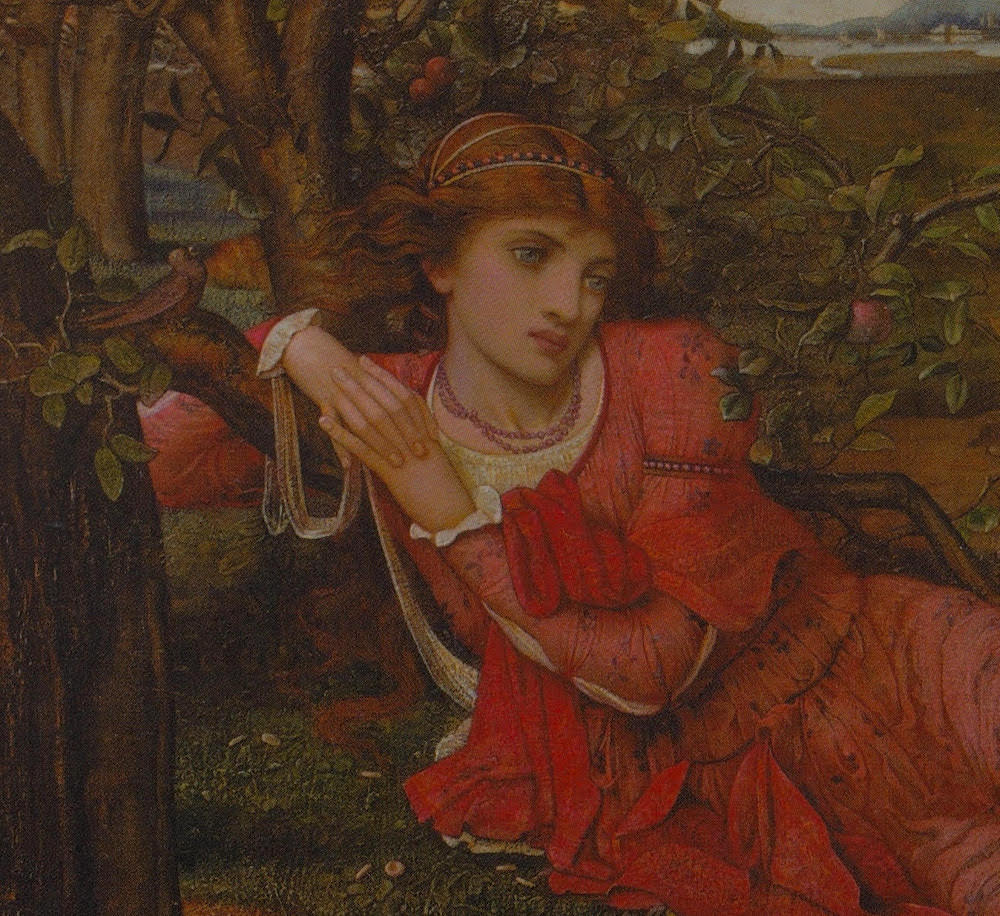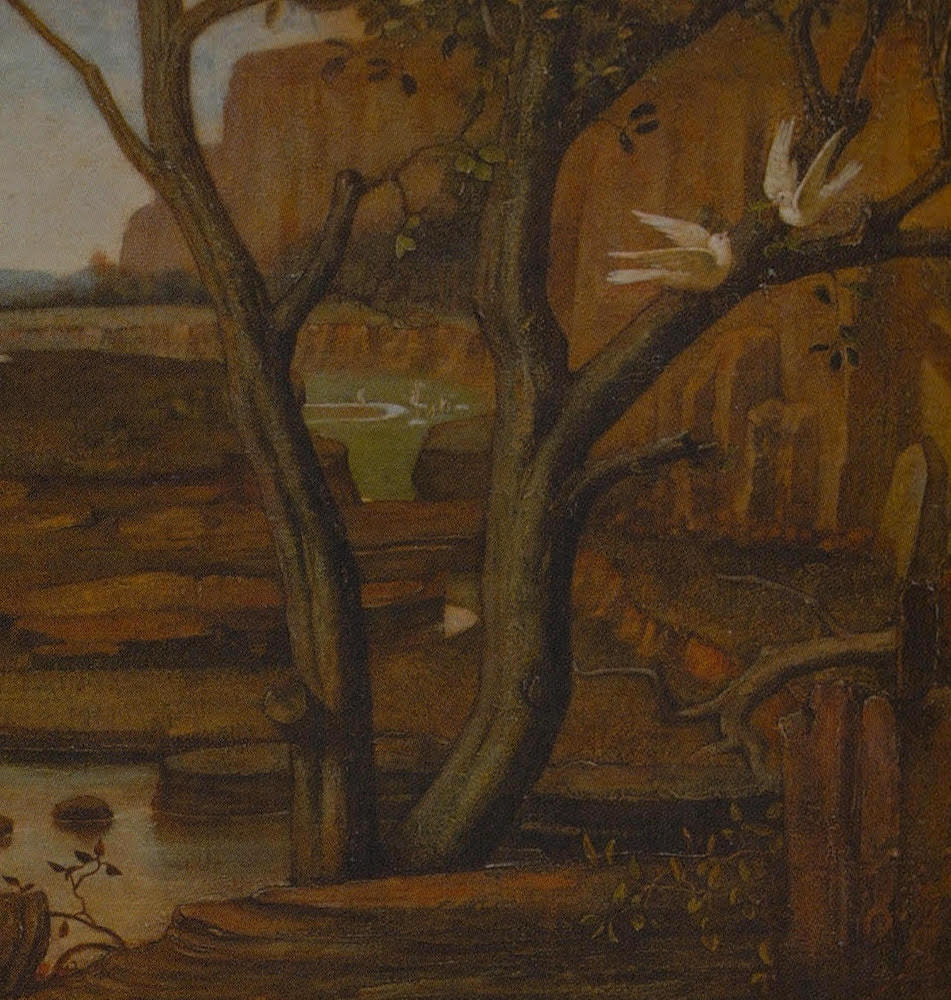
Song without Words, by John Melhuish Strudwick, 1849-1937. 1875. Oil on canvas. 29 1/4 x 39 3/8 inches (74.3 x 99.8 cm). Private collection of Pérez Simón. Image courtesy of Sotheby's. [Click on the images on this page to enlarge them.]
Strudwick had tried unsuccessfully for several years to have a work accepted at the Royal Academy. Finally in 1876 Song Without Words was accepted and hung, no. 577. It was to be the only picture he ever exhibited at the Royal Academy but its purchase by James Carnegie, 9th Earl of Southesk, transformed Strudwick's fortunes and allowed him to set up his own practice with an independent studio.
The painting features a young maiden in a dreamy contemplative mood, with a melancholy expression, and dressed in a pink semi-transparent gown lying on the ground in front of a stream with her hands wrapped around the limb of a tree. She is listening to the sound of a solitary robin perched by her right arm while two courting turtledoves can be seen sitting on a tree branch in the right midground. An apple orchard is in the left midground while the stream gradually winds its way to a lake in the background. The landscape appears to be in Italy rather than England, even though Strudwick had never visited Italy. Véronique Gerard-Powell feels that in its overall effect: "The painting demonstrates the linear elegance and decorative qualities which give Strudwick's work a poetic, dreamlike quality" (171).


Closer views. Left: The young woman's brooding expression as the robin sings beside her. Right: The courting doves amid the Italianate scenery.
The title Song Without Words is taken from a series of eight volumes of short lyrical works written for the piano by the composer Felix Mendelssohn between 1829-1845. This series of works had inspired other English artists, including Strudwick's first mentor John Pettie, whose painting A Song Without Words was exhibited in 1888. Much better known is Frederic Leighton's early Aesthetic Movement masterpiece Lieder ohne Worte of 1861. Neither of these, however, obviously influenced Strudwicks's painting. It does, however, bear a resemblance to works by other members of the second generation of Pre-Raphaelite painters, such as Arthur Hughes's The Rift Within the Lute of 1861-62 or Endymion of 1868-70, and Walter Crane's The Earth and Spring of 1875. Early Florentine Renaissance painters like Botticelli are another obvious influence. Gerard-Powell feels Strudwick's painting was influenced by Edward Burne-Jones's Briar Rose series and his Mirror of Venus of 1875. She also felt the melancholic feeling was reminiscent of the famous Portrait of Edward Herbert, 1st Baron Herbert of Cherbury by Isaac Oliver (c.1610-14; Powis Castle, National Trust)" It is, in turn, possible that Strudwick's work may have inspired the pose of the maiden in J.R.S. Stanhope's Love and the Maiden of 1877 (Gerard-Powell 171). Strudwick may have used the same model for his Song Without Words that Stanhope used for his Venus.
Contemporary Reviews of the Painting
Despite this being the first work by Strudwick exhibited at the Royal Academy it still managed to catch the attention of the critics. The reviewer for the Art Journal found the picture somewhat of an oddity: "Song without Words (577), by J. M. Strudwick, is original in treatment and forcible in colour; but we would advise the artist not to tread near that line which separates originality from eccentricity" (263). W.M. Rossetti in The Spectator admired the decorative qualities of the picture, particularly the colour: "Songs without Words, by J.M. Strudwick, an orchard, heavily laden with fruit, and a rather pre-Raphaelite maiden lying at the foot of one of the trees. Though little more than a piece of decorative drawing, there is a pleasant feeling for colour in the crimson robes and dark fruit and foliage" (739).
Bibliography
Gerard-Powell, Véronique. A Victorian Obsession. The Pérez Simón Collection at Leighton House Museum. London: Leighton House Museum, 2014, cat. 43, 171.
Kolsteren, Steven. "The Pre-Raphaelite Art of John Melhuish Strudwick (1849-1937)" The Journal of Pre-Raphaelite and Aesthetic Studies I:2 (Fall 1988): 11, no. 2.
Rossetti, William Michael. "Art. The Royal Academy." The Spectator XLIX (10 June 1876): 738-40.
"The Royal Academy Exhibition." The Art Journal New Series XV (1876): 261-64.
Victorian Pictures. London: Sotheby's (8 June 1993): lot 22.
Created 25 September 2025
Last modified 7 October 2025